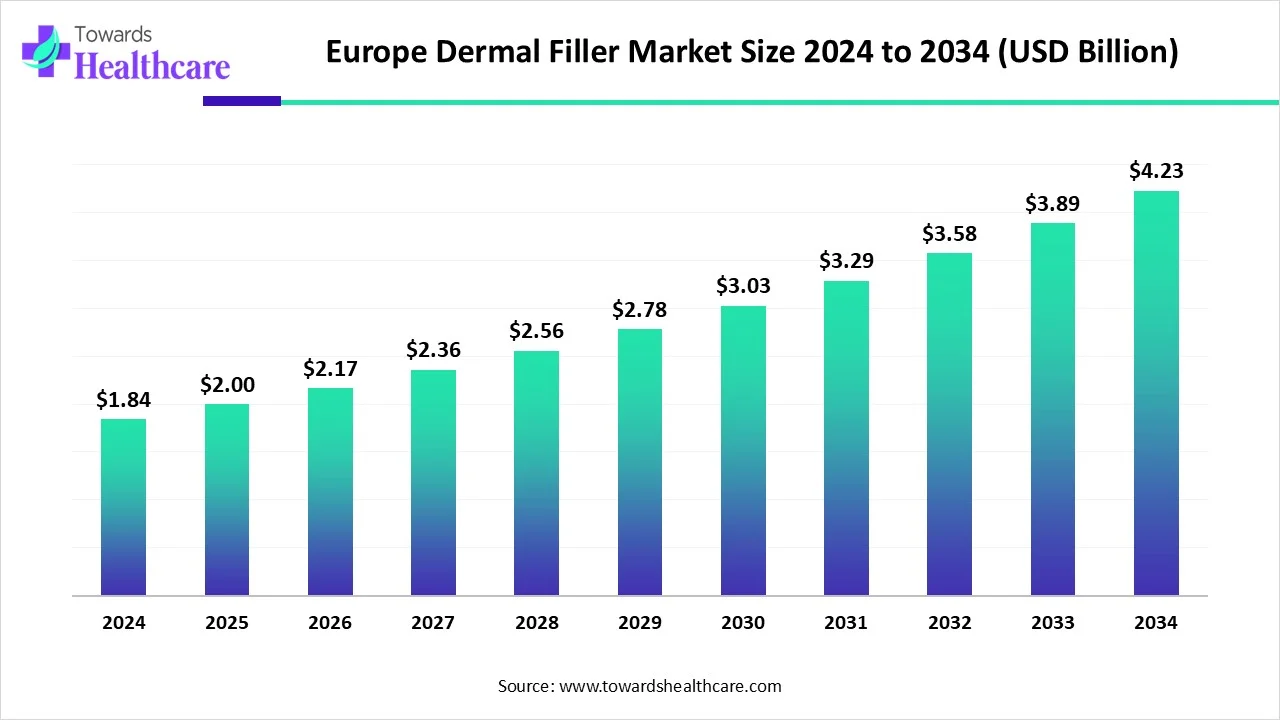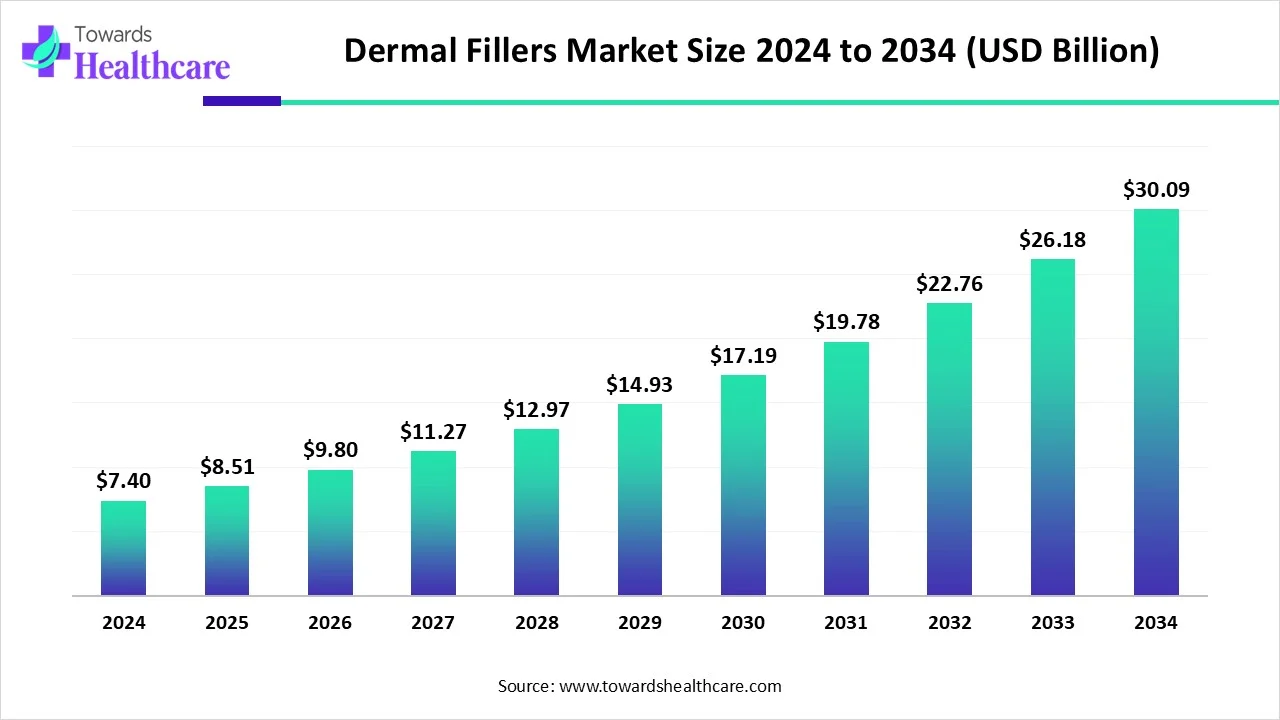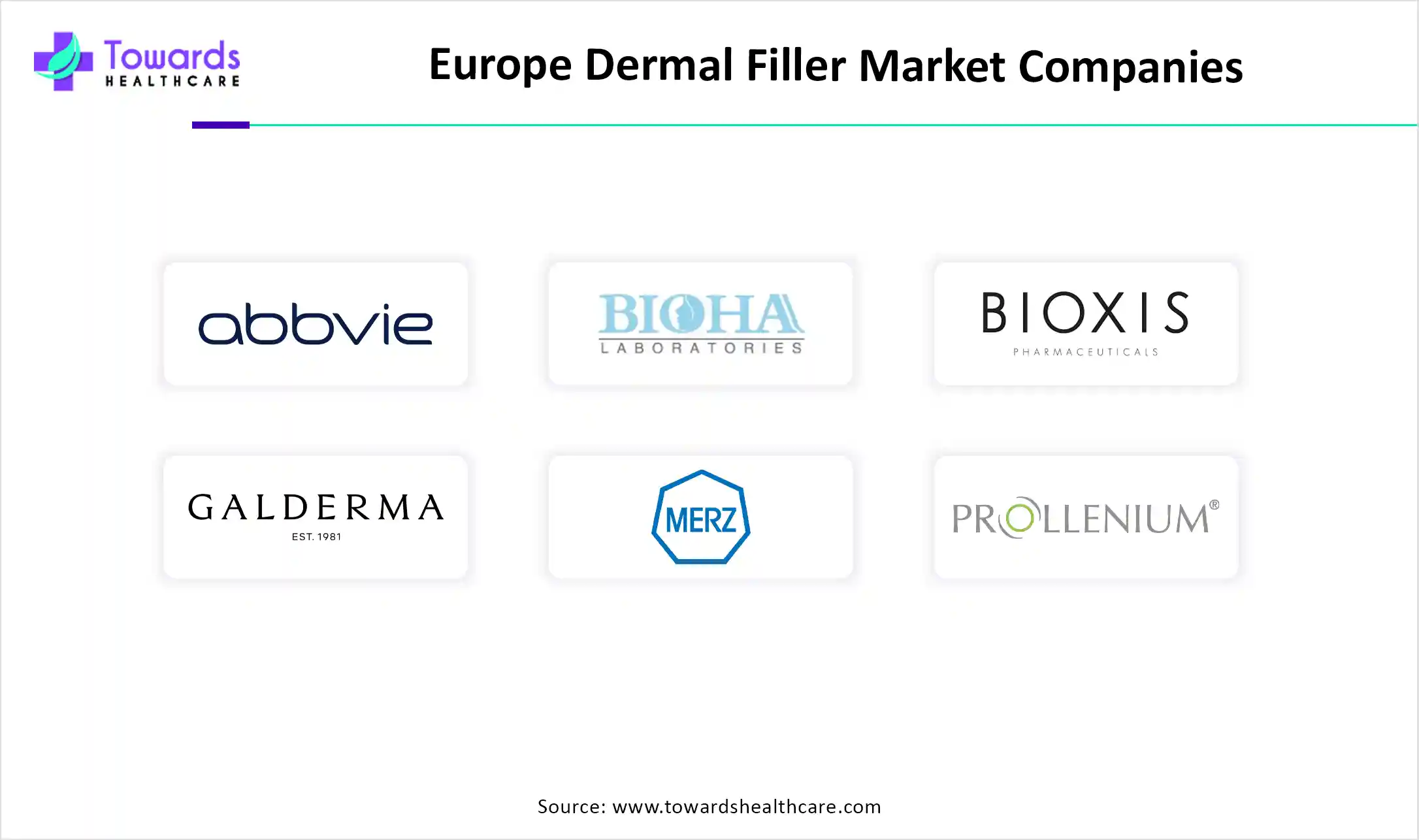October 2025

The Europe dermal filler market size is calculated at USD 1.84 in 2024, grew to USD 2 billion in 2025, and is projected to reach around USD 4.23 billion by 2034. The market is expanding at a CAGR of 8.84% between 2025 and 2034.
There has been a significant desire for less invasive or noninvasive cosmetic operations. Throughout the projection period, the demand for these treatments is anticipated to increase in the majority of developed countries. Improvements in the products brought about by ongoing research and development in the dermal filler industry have had a favorable effect on the market. It results in a high level of customer satisfaction. It is anticipated that the introduction of these new goods would increase demand for cosmetic operations.

| Metric | Details |
| Market Size in 2025 | USD 2 Billion |
| Projected Market Size in 2034 | USD 4.23 Billion |
| CAGR (2025 - 2034) | 8.84% |
| Market Segmentation | By Type, By Application, By End User, By Region |
| Top Key Players | AbbVie Inc, BIOHA LABORATORIES, BIOXIS pharmaceuticals, Galderma SA, Merz Pharma GmbH & Co KGaA, Prollenium Medical Technologies, Sinclair Pharma Ltd, Suneva Medical, TEOXANE LABORATORIES |
The global dermal fillers market is valued at around USD 7.4 billion in 2024 and is expected to grow to USD 8.51 billion in 2025. Looking ahead, the market is projected to reach approximately USD 30.09 billion by 2034, growing at a strong annual rate (CAGR) of 15.07% from 2025 to 2034.

A nonsurgical cosmetic technique called dermal filler injections is used to restore face volume, smooth out wrinkles, and smooth out creases. One of the main factors propelling the market's expansion is the major players' heightened focus on R&D to facilitate and expedite the creation of new goods. The market is growing because more people are becoming aware of non-invasive methods and using these items in a wider range of application areas.
The application of artificial intelligence (AI) is transforming a number of industries, including dermatology. AI has the ability to greatly improve the delivery of fillers, which might improve patient outcomes and efficiency. Artificial intelligence can precisely assess facial features, forecast potential outcomes, and identify areas that can profit from filler treatment. By using this technology, dermatologists could be able to visualize the anticipated results before surgery, which would enhance patient communication and enable better decision-making. AI algorithms may also aid in customized treatment planning by considering factors like as patient preferences, skin type, and facial morphology.
Rising Demand for Minimally Invasive Procedures
The use of minimally invasive procedures has evolved in comparison to more traditional aesthetic and cosmetic surgery treatments, such as lasers and other energy-based devices. For use in either non-surgical or surgical operations, instruments designed for minimum used techniques have been developed. These anti-aging gadgets help to lessen the visual effects of skin aging and provide the impression of younger skin by tightening and regenerating the skin.
High Cost of Dermal Fillers
The high cost of dermal fillers is influenced by a number of factors, including the kind of filler used, the amount required for treatment, the practitioner's degree of experience, the clinic's location, and the reputation of the brand. Fillers that are more specialized and long-lasting, including those that contain poly-L-lactic acid or calcium hydroxylapatite, are usually more costly. Experienced practitioners and clinics in major cities or affluent areas also tend to charge more because of their experience and higher operating expenses.
What is the Future of Dermal Fillers?
From the extraction of animal collagen to various recombinant DNA, nanotechnology, and biostimulation approaches, dermal fillers have evolved. Consumers may now choose from a variety of fillers, including organic fillers composed of calcium hydroxyapatite and hyaluronic acid, as well as synthetic fillers made of poly-L-lactic acid and polymethylmethacrylate. Furthermore, as the effects on society become more obvious, companies and healthcare experts seem to be focused on developing safe, efficient, and equitable products while maintaining stringent review and quality control processes. Therefore, it appears that this medical tool will continue to improve in the future, with fillers expected to play a role as dynamic as the tissues they were created to mend.
By type, the hyaluronic acid segment held the largest share of the Europe dermal filler market in 2024. Soft tissue fillers containing hyaluronic acid (HA) are widely used to rejuvenate, shape, and volumize the face. It is yet unclear how they affect people beyond these aesthetic advantages, particularly how cosmetic HA filler injections affect social and psychological aspects of health.
By type, the calcium hydroxylapatite segment is expected to grow at a significant CAGR in the Europe dermal filler market during the upcoming years. One of the most researched dermal fillers in the world, calcium hydroxylapatite has been widely utilized to restore lost volume and treat moderate-to-severe face creases and wrinkles. Calcium hydroxylapatite is the perfect agent for a comprehensive face approach since it has great flexibility and viscosity as well as the capacity to promote long-term collagen synthesis.
By application, the facial line correction segment dominated the Europe dermal filler market in 2024 and is expected to be the fastest growing during the forecast period. One of the most popular nonsurgical procedures for making the skin on the face firmer and smoother, and less prone to wrinkles, is dermal fillers. Collagen and hyaluronic acid, two ingredients necessary for young skin, are commonly found in fillers.
By end-user, the specialty & dermatology clinics segment led the Europe dermal filler market in 2024 and is expected to be the fastest-growing in the coming years. The need for cosmetic procedures and greater awareness of skin disorders are fueling the expansion of dermatology and specialist clinics. The increasing incidence of skin conditions, including psoriasis, eczema, and acne, as well as the expanding need for cosmetic dermatological services, are major factors. The market is growing as a result of telehealth's popularity and technological developments.
The region's rise may be ascribed to increased investment in research and development (R&D) as well as people's growing demand for dermal filler operations in important European nations. Increased disposable incomes and shifts in European customers' attitudes regarding non-surgical methods of enhancing their aesthetic appearance have led to a surge in their use. Due to their high level of safety and positive patient results, these treatments are in high demand among European customers.
Because of its rapid advancements, shorter turnaround times, and growing aesthetic sensibility, Germany dominated the market in 2024. Italy has the second-biggest senior population globally and the largest geriatric population in Europe. This nation's supremacy is ascribed to its sophisticated healthcare system and high public knowledge of cosmetic treatments, which has resulted in a sharp rise in the number of procedures performed.
In September 2023, Concerns about dishonest practitioners prompted the government to initiate a consultation to determine how to make non-surgical cosmetic procedures like Botox safer. An estimated 900,000 injections of botulinum toxin are performed annually in the United Kingdom. To carry out certain operations, practitioners and the locations from which they operate will need to have licenses under the planned program, which will be controlled by local authorities in England.

In July 2024, Galderma launched a highly unique and cutting-edge neuromodulator with RelfydessTM, reaffirming our leadership and rapid expansion in this industry as well as our dedication to creating and providing the widest range of injectable aesthetics products. Our teams are now completing the country-level regulatory processes in accordance with the decentralized European model, so we're prepared to launch in several regions early next year, stated FLEMMING ØRNSKOV, M.D., MPH, CHIEF EXECUTIVE OFFICER, GALDERMA (Source - Galderma)
By Type
By Application
By End User
By Region
October 2025
October 2025
October 2025
October 2025